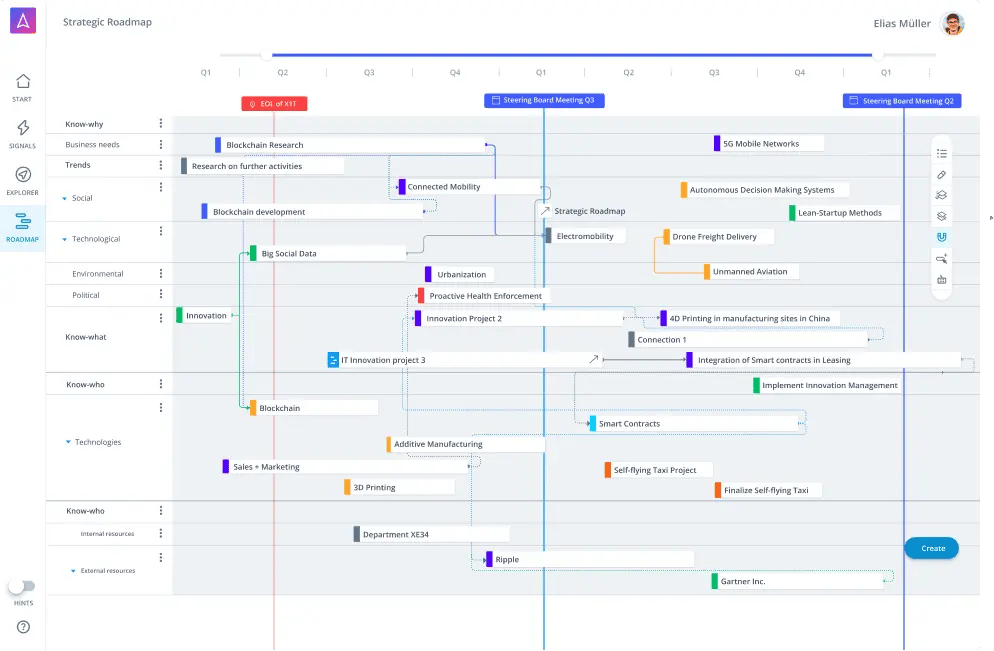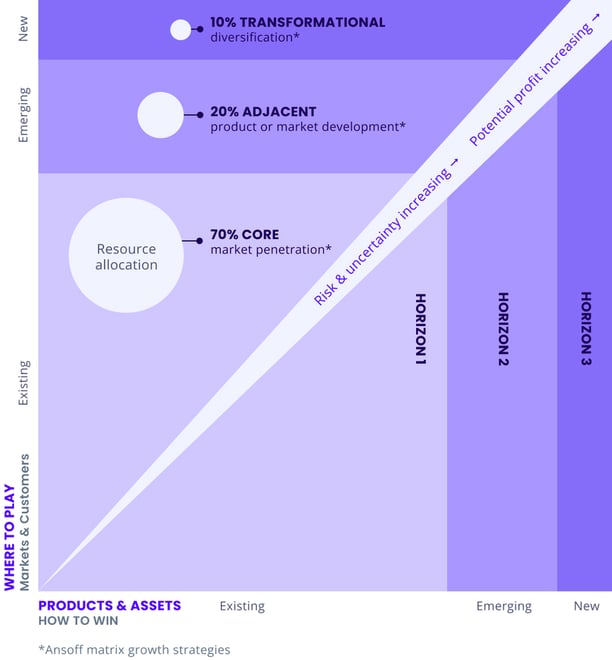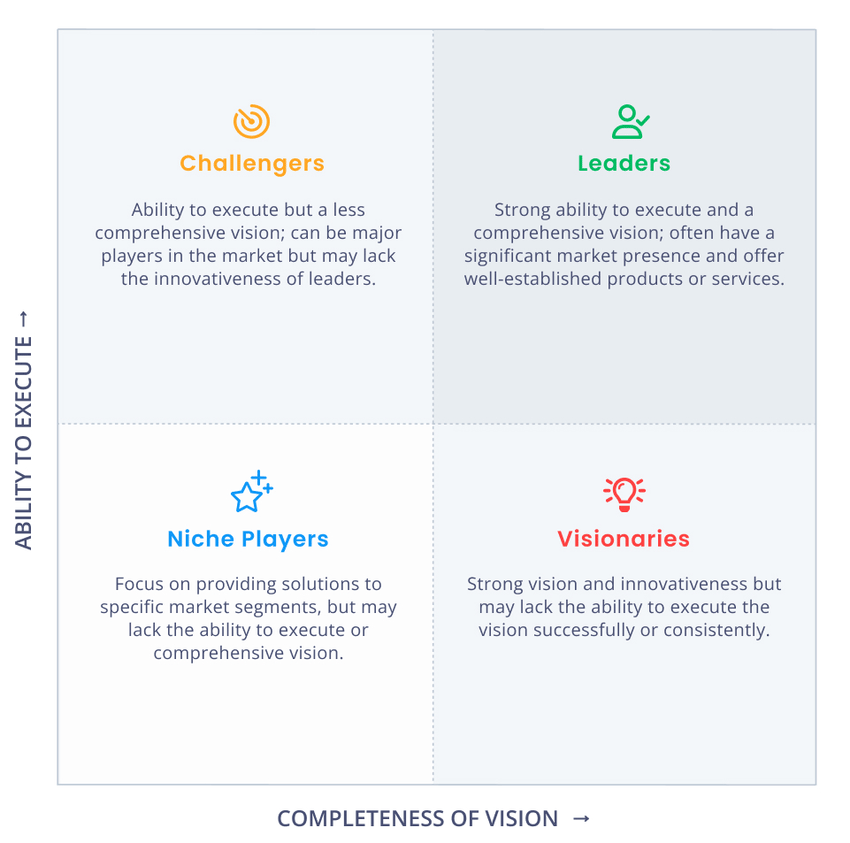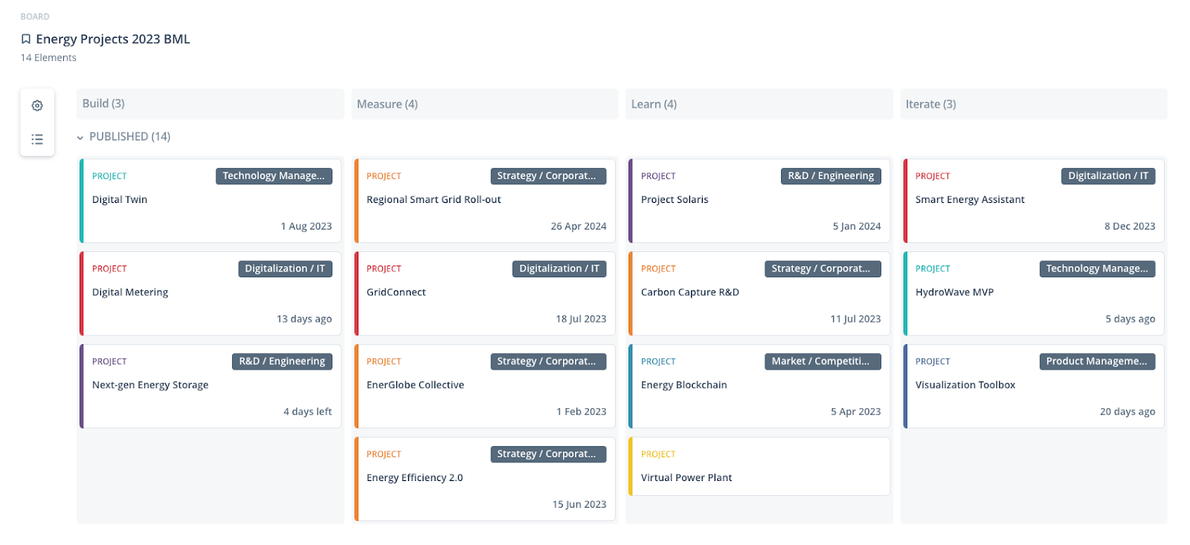Innovation spending is at an all-time high. According to Accenture, organizations invested $3.2 trillion in innovation between 2017 and 2022. But in the same period, returns on innovation spending declined 27%.
Why the gap? Many companies fail to deliver tangible results, not necessarily due to a lack of organizational commitment or misguided strategy, but rather because they are not equipped with the right set of methods, tools, and techniques to move systematically from strategy to execution.
In this blog, we explore ten of the most effective innovation portfolio management methods to help you ensure the right efforts are resourced and delivered at the right time. By operationalizing and connecting these best-practice methods in a single end2end operating system, portfolio managers can align their organization’s investment strategy with business goals and actions. Read on to learn best practice for streamlining the portfolio management process and, ultimately, maximizing return on innovation.
1. Roadmaps
A roadmap is a visual representation of the milestones and deliverables required to manage an organization’s transition from its current state to a future state over a specific time period. It integrates layers of information—including market conditions, products, technologies, internal capabilities, and resources—to provide a high-level overview of all innovation activities and strategy execution.
An innovation roadmap is also effective for day-to-day operational planning and execution. It breaks down plans into clear steps with assigned responsibilities. With greater oversight, teams can quickly match resource allocation with strategic priorities, identify synergies, and mitigate bottlenecks to streamline project delivery.

Agile innovation roadmaps for translating strategy into action
Use ITONICS Roadmap to easily build agile multi-layered roadmaps, linking foresight and ideation activities with portfolio initiatives, strategic goals, and more. You can configure a custom roadmap or select from one of ITONICS’ best-practice roadmap templates to get started quickly.
2. Ansoff matrix
The Ansoff matrix is a strategic tool for analyzing and prioritizing growth strategies within an organization’s innovation portfolio. It provides a framework for evaluating various options for growth based on two dimensions: product (existing to new) and market (existing to new).
The Ansoff matrix consists of four growth strategies: market penetration, product development, market development, and diversification. It helps businesses assess their risk appetite and identify growth opportunities by considering different combinations of product and market strategies.
3. 70-20-10 rule
The 70:20:10 rule is a guideline often used for resource allocation in innovation portfolio management. It recognizes the importance of balancing short-term stability with long-term innovation by dedicating resources to different types of initiatives.
The rule promotes innovation portfolios that focus on both exploiting existing capabilities and exploring new possibilities. It suggests the following allocation of innovation resources: 70% on core business, 20% on adjacent opportunities, and 10% on transformational opportunities.

The ambition matrix for aligning and balancing innovation portfolios
Other frameworks like the Three Horizons from McKinsey & Company and the Ansoff matrix are sometimes integrated with the 70-20-10 rule to steer innovation portfolio management and improve future resilience. The combination of these frameworks gives rise to the ambition matrix, shown above.
4. Gartner Magic Quadrant
The Gartner Magic Quadrant provides a graphical representation of a market's direction, maturity, and participants, as well as their ability to deliver on certain criteria. It divides technology providers into four quadrants based on two primary axes: completeness of vision and ability to execute.

Gartner Magic Quadrant for analyzing and assessing technology providers based on their vision and ability to execute
The Magic Quadrant serves as a valuable resource for organizations looking to make informed decisions about innovation-related investments. It provides an overview of the competitive landscape, allowing organizations to compare vendors and select the ones that align best with their innovation goals, requirements, and risk tolerance.
5. Phase gate
A phase gate is a structured and sequential approach used to manage, evaluate, and execute projects at various phases of their development. The purpose of a phase-gate process is to enable effective decision-making throughout a project's life cycle.
By implementing phase gates, organizations can ensure that projects align with strategic objectives, meet predetermined criteria, and have the necessary resources to proceed. This approach reduces the risk exposure of investing in projects that may fail to deliver the expected outcomes or align with business priorities.
Use ITONICS Ideation and Portfolio to systematically move ideas, projects, and other assets forward, identify bottlenecks, and streamline delivery. With workflows in ITONICS, you can configure custom phase-gate processes, automate tasks, strengthen oversight, and ensure the efficient execution of your most critical innovation initiatives.
6. Value co-creation
Value co-creation refers to the collaborative process of value creation between a company and its customers or other stakeholders. It recognizes that value is not solely generated by the company but is co-created through interactions, engagements, and collaborations with external parties.
Value co-creation influences the way projects are planned, executed, and monitored. Project managers must actively involve customers and stakeholders in defining requirements and capturing and incorporating their inputs into the project management process. These inputs can shape the project's direction, features, and overall value proposition.
7. Project triage
Project triage is a systematic approach for prioritizing and allocating resources to projects based on their potential impact, feasibility, and strategic alignment with an organization's goals. It is typically used by innovation portfolio managers when there are multiple project proposals or ideas that require evaluation and selection.
Project triage begins by first centralizing all potential project proposals, performing an initial screening to eliminate proposals that do not meet the pre-defined evaluation criteria, and rating the remaining proposals to determine a ranking order for prioritization, resource allocation, and eventual execution.
8. Build-measure-learn
The build-measure-learn (BML) approach is a fundamental concept in the Lean Startup methodology, which focuses on iterative and validated learning in developing new products or services. The BML approach emphasizes the importance of hypothesis testing, customer feedback, and continuous improvement.
BML helps teams minimize the risk of building products or services that do not meet customer needs or have low market demand, ultimately increasing the chances of success and reducing waste in the innovation process.

Kanban boards for easily visualizing the build-measure-learn approach in portfolio management
Use ITONICS Portfolio to operationalize the build-measure-learn approach in your innovation program. With Portfolio, you can configure Kanban boards and phase-gate processes to align with your project stages, allowing for quick insights and continuous improvement throughout the end2end portfolio management process.
9. Prototype
A prototype is an early-stage model, pilot, or representation of a product or service. It is created to test and validate design ideas and explore the feasibility of concepts before investing significant resources in full-scale development. Prototyping allows companies to gather feedback from potential users early, leading to higher adoption rates and customer satisfaction.
Prototyping also facilitates an iterative design process. Companies can quickly build, test, and refine prototypes based on user feedback and iterate multiple times to improve a product's design and functionality.
10. The chasm
More a concept than a method, the chasm was introduced by Geoffrey A. Moore in his book "Crossing the Chasm." It refers to a significant gap or barrier that exists between early adopters and the early majority in the adoption curve. The chasm represents the challenge of transitioning from a relatively small group of enthusiastic early adopters to a larger, more skeptical mainstream market.
To successfully navigate the chasm, portfolio managers must understand market trends and the distinct characteristics of the early majority. With this insight, companies can develop strategies to address the early majority's concerns, mitigate risks, and communicate the value and benefits of the innovation in a way that resonates with their needs.
Build your custom innovation toolbox for innovation portfolio management
Innovation is not a one-size-fits-all endeavor, and the effectiveness of these portfolio management methods depends on your organization’s unique circumstances. To maximize your return on innovation, it's essential to carefully consider how to tailor your approach.
Selecting the right mix of innovation methods requires careful consideration of your organization's goals, the specific challenges you're addressing, the capabilities of your team, and the evolving business landscape.
Innovation Portfolio Managers can use the ITONICS Innovation Toolbox as a starting point for determining the set of methods that are right for their team, use cases, and objectives. It is an ultimate resource hub to support Innovation Portfolio Managers in decision-making and execution.
The toolbox contains the methods mentioned here, along with many more best-practice tools, techniques, and concepts for enhancing the portfolio management process, as well as foresight, ideation, and innovation governance. Each method is interlinked with solutions, templates, and tips from the ITONICS Innovation OS to quickly put your innovation plans into practice.
Unlocking the full potential of your innovation portfolio with ITONICS
ITONICS Portfolio provides the oversight, agility, and governance needed to streamline your innovation projects and move quickly from strategy to value realization. Capabilities like collaborative rating, roadmapping, and reporting ensure that the right efforts are resourced and delivered at the right time—to turn your growth plans into reality.
The ITONICS Innovation OS is an end2end collaborative platform that links innovation portfolio management to your goals and objectives. With all your innovation intelligence and activities in one central location, you can more easily identify synergies and opportunities for collaboration while removing inefficiencies and bottlenecks that could threaten to steer your portfolio off course.
- Use collaborative ratings to evaluate the feasibility and urgency of opportunities.
- Balance quick wins and moonshots in your portfolio to smartly guide resource allocation.
- Report on progress easily with transparent views on the status of projects and tasks.
- Align teams and projects across your organization with integrated and agile roadmaps.
- Increase hit rates by connecting external drivers of change and internal capabilities with your innovation projects.
Want to learn more about maximizing your return on innovation through effective strategy realization with ITONICS? Get a free demo and see for yourself!









